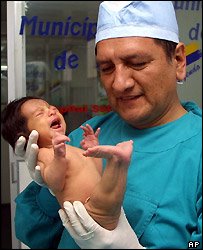 Both of the programmes we've seen have explored the impact of the birth of infants with unusual genetic deformities on developing world communities caught between traditional and modern mindsets.
Both of the programmes we've seen have explored the impact of the birth of infants with unusual genetic deformities on developing world communities caught between traditional and modern mindsets.First there was little Milagros Cerrón Arauco, la sirena, born in Peru with fused legs, a single kidney and her sexual organs trapped in her rectum. (Sirenomelia)
Her parents were dirt-poor Andean indios whose friends and family bitterly blamed the mother's visits to the local lake for this mermaid's curse. Soon the child's biological relatives had become almost an irrelevance, displaced by a media circus stirred up by politico-physician Dr Luis Rubio, a white-suited populist who gets about in a stretch limo surrounded by 'nurses' in mini-skirts.
Baptised in the cathedral by the Bishop of Lima with the city mayor as her godfather, Milagros' fragile life was acquiring an artifical value as a unique specimen and as a foil for her saviours' self-congratulatory discourse. This biologically unlucky baby would become "a technical and artistic miracle", asserted her ambitious surgeon, and a symbol to simple people of superstitious bent everywhere that there is a salida (way out) for children with serious birth defects. We were informed at the end that Dr Rubio has moved on to 'Lobster Boy'.
This week we were taken to Egypt where a baby girl called Manar Maged was born with the fully-formed head and brain of her twin sister attached to her skull. The condition is known as craniopagus parasiticus and results when the circulatory system of one of a pair of conjoined twins fails early in pregnancy. As with the Peruvian baby it was pretty clear that the parents dearly hoped that the child would perish momentarily (as the gringos say), though the interviewers encouraged them to awkwardly relate a narrative of struggle and hope. (I doubt however that their immediate ancestors would have had any qualms about assisting the passing of such an unfortunate soul.)
If the case of the mermaid was interesting primarily for the way it unfurled the human geography of contemporary Latin America, here there were both sharper ethical issues (the parasitical head could react to stimuli and express emotion) and a more deeply fascinating biological one. There's selfishness going on here, but not just at the gene or mass media level. What kind of individual and collective interaction of embrionic genetic code decides to create a perfectly-formed human head attached to a stump instead of a fully-developed 'survival machine'? And when it lost its own blood supply, how did the twin know how to tap into its sibling's and to form that particular subset of a complete person, rather than the rather messier alternatives?

No comments:
Post a Comment